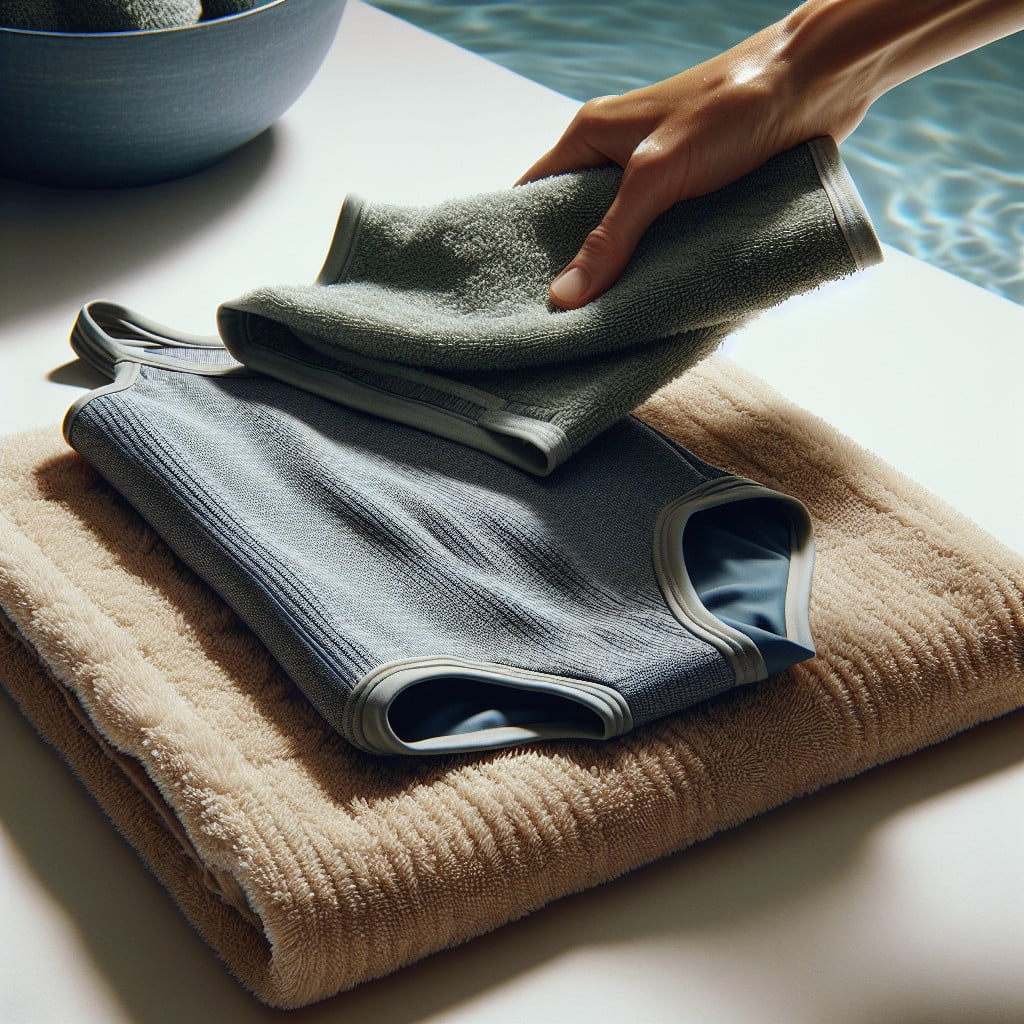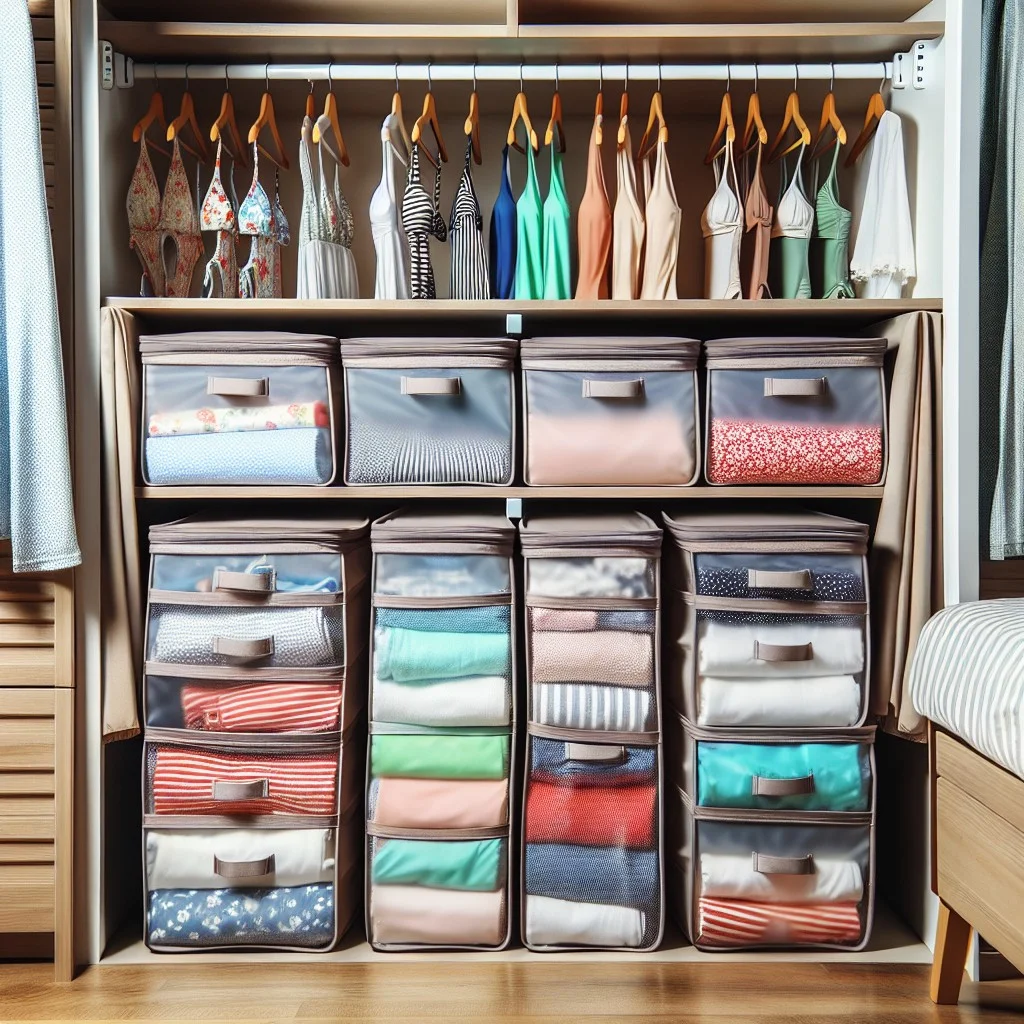Last updated on
Preserving the longevity and elasticity of bathing suits becomes more effortless due to the proper storage techniques outlined in this article, because everyone desires beautiful and durable swimwear.
Key takeaways:
- Rinse your suit after use to remove chlorine and oils.
- Gently squeeze out excess water and air dry.
- Store swimsuits in a cool, dry place away from sunlight.
- Organize by type or pattern to easily find what you need.
- Use breathable fabric pouches, not plastic bags, for storage.
Wash Your Suit After Use

Rinsing your bathing suit in cold water immediately after use helps remove chlorine, salt, oils, and sunscreen, which can break down the fabric over time. If a thorough wash isn’t possible right away, a quick rinse will mitigate damage until a proper clean.
For best results, turn your swimwear inside out and hand wash with a gentle detergent designed for delicates. Avoid wringing out the suit, which can stretch the fibers; instead, press the water out gently.
Resist the temptation to soak swimsuits for prolonged periods, as this can lead to color bleeding, especially in brightly colored or patterned items. Always air dry away from direct sunlight to preserve elasticity and color integrity before storing.
Dry Carefully

Gently squeeze out excess water from your swimsuit immediately after washing, taking care not to twist or wring the fabric which can lead to deformation. Lay it flat on a clean, dry towel and roll it up to absorb most of the moisture.
Then, unroll the towel and place the bathing suit on a dry section or a fresh towel, spreading it out neatly to maintain its shape. Air dry away from direct sunlight and heat sources as these can fade colors and degrade stretch fibers.
If possible, hang it up on a drying rack that allows for air circulation on both sides to speed up the drying process without stretching the fabric. Remember, swimsuits are made of delicate materials designed to dry quickly, so they should never be placed in a dryer.
Store Swimsuits in a Cool, Dry Place

To ensure the longevity of your swimwear, it’s essential to find the right spot in your home for storage. Moisture and heat can be the biggest culprits when it comes to fabric damage, so seek out an area that is consistently cool and dry.
A bedroom closet or a dresser drawer away from high humidity areas like bathrooms or laundry rooms works best.
Bear in mind, extreme temperatures can degrade the stretch and color of swimsuit fabrics. Therefore, avoid storing them in attics or basements where conditions can fluctuate with the changing seasons.
If you’re short on space, consider under-the-bed storage containers which provide a good alternative while maintaining the necessary environment for your suits.
Organize Bathing Suits By Type or Pattern

When organizing your swimwear, sorting by type streamlines your selection process and keeps pairs together. Bikinis, tankinis, one-pieces, and swim trunks should each have their dedicated spot. This method prevents the frustration of rummaging through a mixed pile when you’re looking for something specific.
Additionally, grouping by pattern or color can add visual appeal to your drawer and makes it easy to mix and match tops and bottoms if you like to personalize your swim attire. Solid colors can be separated from patterns, and darker hues can be placed away from lighter shades to avoid color transfer. This simple yet effective approach ensures your swimwear drawer is not only organized but also aesthetically pleasing.
Use Drawer Dividers for Separation
Drawer dividers can transform your swimwear storage by keeping each piece accessible and in good shape. Assign a specific compartment for bikinis, one-pieces, and cover-ups to streamline your selection process. By separating different styles, you avoid the tangle of straps and the strain on delicate fabrics that comes from digging through a pile.
Additionally, maintaining a dedicated spot for each suit simplifies maintenance checks, allowing you to identify and address any wear or tear quickly. This method not only preserves the condition of your swimwear but also makes packing for a beach getaway a breeze. Keep your swimwear in pristine condition and ready for the next sun-soaked adventure with this simple organizational hack.
Avoid Hanging Swimsuits for Long-Term Storage
While it might seem convenient to hang your swimsuits in the closet with other garments, doing so can stretch out the delicate fabric over time. The weight of the wet material may cause the straps to elongate and lose their elasticity.
Instead, lay them flat in a drawer or on a shelf. If you must hang a swimsuit for a short period, avoid using metal hangers, as they can leave rust stains; opt for wide-shouldered plastic or padded hangers instead.
Remember, the goal is to preserve the swimsuit’s shape and avoid unnecessary strain.
Opt for Breathable Fabric Pouches Over Plastic Bags
Choosing breathable fabric pouches for storage is a savvy move for several reasons:
1. Moisture Control: Unlike plastic bags, fabric allows air to circulate, preventing dampness and reducing the risk of mold and mildew growth, which can damage your swimsuit’s material and aesthetic.
2. Material Integrity: Swimsuits often have elastic components that can deteriorate in airtight conditions. Breathable pouches help maintain the elasticity and shape of your suit.
3. Preventing Odor: Enclosed spaces can trap odors. Using a fabric pouch helps your suit stay fresh, ready for its next use.
4. Eco-Friendly Option: Fabric pouches are reusable and more environmentally friendly compared to disposable plastic bags, aligning with a sustainable approach to wardrobe maintenance.
5. Gentle on Fabrics: Soft fabric pouches are gentle on the swimsuit’s material, avoiding snags or tears that might occur from being jostled in a drawer.
Remember to avoid storing wet suits; always ensure your bathing suits are dry before storing them away.
Rotate Swimsuits to Prevent Prolonged Folding in One Position
When you have multiple swimsuits, it’s advantageous to alternate which ones you wear and store on top. Consistently folding swimsuit fabric in the same spot may eventually lead to crease marks or loss of elasticity.
To maintain the shape and integrity of your swimwear, periodically change their positions in your drawer. This practice is akin to rotating tires; it ensures even wear and prolongs the life of the material.
Consider laying swimsuits flat or rolling them to avoid hard creases. Shifting their position in storage also gives you a chance to inspect each one for wear and tear, allowing for timely repairs or replacement.
Check for Damages Before Seasonal Storage
Before tucking away your swimsuits for the off-season, take the time to inspect each piece for signs of wear and tear. Look for stretched-out straps, loose threads, or hooks that may need repair. Also, check for fading or discoloration, especially in areas that have been in contact with sunscreen or chlorine.
If you discover small holes or tears, consider mending them to prevent further damage during storage. This proactive approach ensures your bathing suits remain in prime condition, ready for the sun and surf when summer rolls back around.
Remember, addressing minor issues now can extend the life of your swimwear, saving you time and money in the long run.
Use Silica Gel Packets to Avoid Moisture Build-Up
Including silica gel packets among stored swimwear can safeguard against mold and mildew by absorbing any residual dampness that might linger after drying. These tiny desiccants are powerhouse moisture combatants and can be particularly useful in climates with high humidity.
Here are some points to keep in mind:
- Slip one or two silica gel packets into the drawer or storage container where your swimwear is kept.
- Replace the packets periodically to ensure effectiveness, especially if you’ve noticed they’ve become saturated.
- Consider the size of your storage area when determining the number of packets needed; a larger drawer may require additional packets.
- Never place silica gel packets directly on the fabric to avoid any potential for discoloration or damage; instead, place them beside or between suits.
- Keep these packets out of reach of children and pets, as they are not meant to be ingested.
Store Away From Direct Sunlight to Prevent Fading
Ultraviolet rays from the sun can break down the fibers in your swimsuits and cause the colors to lose their vibrancy. To maintain the appearance and longevity of your swimwear:
- Choose an indoor storage area away from windows or skylights.
- Draw the curtains or blinds in your closet or room if indirect sunlight is still a concern.
- Consider using a dresser drawer, away from external walls, which may heat up and transmit light.
- If you must use a space with potential for indirect light exposure, cover the swimwear with a light-colored, opaque cloth for an extra layer of protection.
Folding Techniques for Maximizing Drawer Space
To maximize drawer space, consider the file-folding technique, which involves folding your swimsuits into neat, compact rectangles that can stand upright side by side. This not only saves space but also allows you to see all your options at once, making it easier to pick out the suit you want to wear.
For bikinis or two-piece suits, stack the bottoms and then fold the top in a way that both pieces can nestle together, reducing any dead space. For one-piece suits, fold in the sides to create a narrow strip, then fold up from the bottom to match the size of your folded bikinis for uniformity.
By maintaining this organization, you’ll preserve the shape and condition of your swimsuits while also keeping your drawer uncluttered and accessible.
The Importance of Storing Your Swimsuits Properly
Proper storage extends the life of your swimwear by maintaining its shape, color, and elasticity. Improper practices can lead to stretched-out materials, faded colors, and weakened fibers, which may result in a less flattering fit and reduced support. By investing a little time and care in storing your bathing suits, you’ll ensure they remain as vibrant and comfortable as the day you bought them.
Here are some key points to remember when storing swimwear:
- Elasticity preservation: Keeping suits in a relaxed state without tension prevents the elastic from stretching out.
- Color care: Storing away from sunlight protects vibrant patterns and hues from fading.
- Mold and mildew prevention: Ensuring swimsuits are dry before storing them helps to avoid unsightly and damaging mildew growth.
- Shape retention: Proper folding or laying flat helps maintain the original contour and fit.
- Accessibility: Organized storage makes it easier to find and rotate between different swimwear options.
By following these guidelines, your swimwear will be ready to make a splash season after season.
Why Is It Necessary to Store Swimsuits Separately?
Storing swimsuits separately serves several purposes:
- It prevents color transfer from darker to lighter garments, which can occur when materials with vibrant dyes are stored together, especially if they become damp.
- The distinct materials used in swimsuits, like spandex or Lycra, can react with other fabrics causing them to stretch or degrade over time.
- Isolating swimsuits ensures that any residual chlorine or saltwater, which might not be entirely removed even after rinsing, doesn’t affect other clothing.
- Separation allows airflow around each swimsuit, preventing mildew growth and ensuring the fabric stays fresh.
- It simplifies the process of finding your swimwear when needed, as they are all in one location, eliminating the need to sift through other clothing items.
Do: Rinse Your Swimsuit After Every Use
Rinsing your swimsuit immediately after use helps remove chlorine, salt, sand, and body oils that can damage the fabric over time.
Using cold water without any detergents preserves the suit’s elasticity and color vibrancy.
Gently squeeze out excess water – avoid wringing, as this can stretch the fibers.
This step is crucial for maintaining the condition of the suit before the next wear and before you commit it to storage.
Remember, a well-cared-for swimsuit means fewer replacements and better performance whenever you dive in.
FAQ
How should I store my swimsuits?
For long-term storage, place your swimsuits in a cool, dry environment along with a few silica gel packs to prevent dry rotting.
How do you store swimsuits in the winter?
In the winter, swimsuits should be stored in a dark, dry, and cool area with sufficient airflow, ideally separated in a dedicated drawer.
What are the best materials for swimsuit storage solutions?
The best materials for swimsuit storage solutions are breathable fabrics like cotton or mesh, waterproof materials like nylon or plastic, and durable materials like canvas or metal.
What is the proper method for folding swimsuits for storage?
The proper method for folding swimsuits for storage involves laying the swimsuit flat, folding it in half lengthwise ensuring that the top and bottom edges align, then folding it in half again widthwise ensuring the side edges align.
How can the lifespan of swimsuits be extended through proper storage?
The lifespan of swimsuits can be extended through proper storage by thoroughly rinsing them in cold water after each use, allowing them to dry completely away from direct sunlight before storing flat in a cool, dry environment.
Recap:




